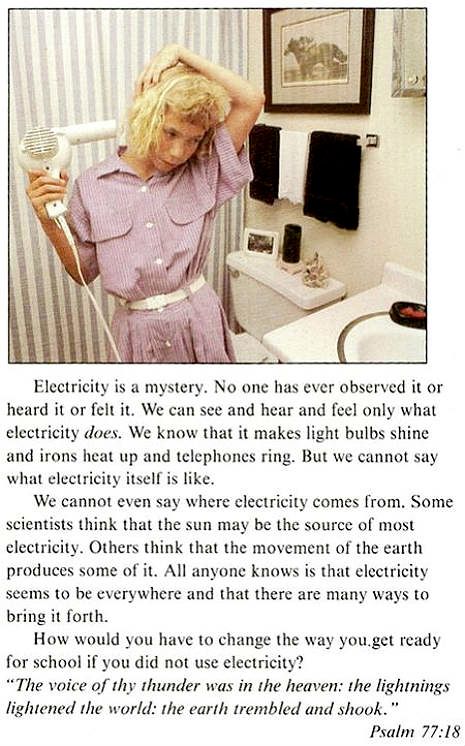I came across this excerpt from a a christian home schooling book:
which is of course funny in so many ways not at least as the whole process of "seeing" is electromagnetic at its very core and of course most people will have felt electricity at some point in their life. Even historically, this is pretty much how it was discovered by Galvani (using forge' legs) at a time when electricity was about cat skins and amber.
It also brings to mind this quite famous Youtube video that shows Feynman being interviewed by the BBC and first getting somewhat angry about the question how magnets work and then actually goes into a quite deep explanation of what it means to explain something
I would define magnetism as the force that moving charges feel in an electromagnetic field (the part proportional to the velocity) or said the other way round: The magnetic field is the field that is caused by moving charges. Using this definition, my interpretation of the question about magnets is then why permanent magnets feel this force. For the permanent magnets, I want to use the "they are made of tiny magnets" line of thought but remove the circularity of the argument by replacing it by "they are made of tiny spins".
This transforms the question to "Why do the elementary particles that make up matter feel the same force as moving charges even if they are not moving?".
And this question has an answer: Because they are Dirac particles! At small energies, the Dirac equation reduces to the Pauli equation which involves the term (thanks to minimal coupling)
$$(\vec\sigma\cdot(\vec p+q\vec A)^2$$
and when you expand the square that contains (in Coulomb gauge)
$$(\vec\sigma\cdot \vec p)(\vec\sigma\cdot q\vec A)= q\vec A\cdot\vec p + (\vec p\times q\vec A)\cdot\vec\sigma$$
Here, the first term is the one responsible for the interaction of the magnetic field and moving charges while the second one couples $$\nabla\times\vec A$$ to the operator $$\vec\sigma$$, i.e. the spin. And since you need to have both terms, this links the force on moving charges to this property we call spin. If you like, the fact that the g-factor is not vanishing is the core of the explanation how magnets work.
And if you want, you can add spin-statistics which then implies the full "stability of matter" story in the end is responsible that you can from macroscopic objects out of Dirac particles that can be magnets.




1 comment:
Oh dear, that excerpt is really so ridiculous. Are you sure it's real?
Post a Comment